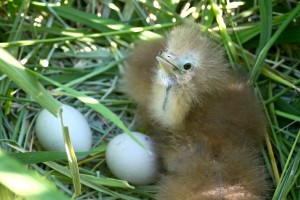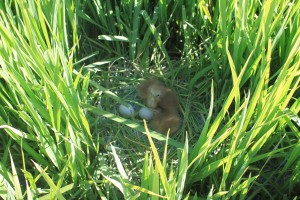Bitterns in Rice Project Update by Matt Herring
It’s with great joy that I share this news. Any niggling doubts I’ve had about the likelihood of widespread breeding in rice crops have evaporated. There it was – a glowing beacon of bittern reproduction: three chicks and two eggs. After so much effort, I was beginning to worry that someone would find that I’d ‘bittern the dust’ out in a rice paddock somewhere without having found a single nest!
Since last season, we’ve known that very significant numbers of the endangered Australasian Bittern (Botaurus poiciloptilus) use rice crops in the NSW Riverina. Many things have pointed toward there being widespread breeding, but until now the Bitterns in Rice Project had been unable to find an active nest or other conclusive evidence of breeding in rice crops.
The landholders are delighted. Like many rice farmers, they’re familiar with this special bird and have a real soft spot for them. There is plenty of time for the chicks to fledge (approx. 55 days) before their crop is harvested. And in a bizarre coincidence, the property is called ‘Tarkoori’, an Aboriginal word for Australasian Bittern. I presume the ‘Tar’ is the male sucking air in and the ‘koori’ is the boom. Go on, try it.
Sure, it’s only one nest, but more are bound to follow, and the site is just one of many randomly selected rice farms (with aerially-sown or dry-sown crops) in the Coleambally region where bitterns have been recorded. As of yesterday, across the NSW Riverina rice-growing regions, we passed the 50-individual mark for bitterns confirmed in rice crops this season.
It’s clearer than ever that birds don’t arrive in the crops until the rice is about 30 cm and in mid-December that meant a smaller proportion of sites supported them because of the late season. From where they came once the crops were tall enough, we can only speculate. It’s intriguing. There are already a few sites that now have rice above 80cm and if last season is any indication, the males will quieten by about mid-February, so we only have a couple of weeks of the main survey window remaining.
Stay tuned, as we interrogate the data, comparing bittern and non-bittern sites, so we can continue to develop our bittern-friendly rice-growing tips for interested growers. This really is a wonderful example of how Australian farms can simultaneously produce food and support endangered species.
All rice farmers are asked to keep their ears and eyes out for bitterns, especially on dawn and dusk. Sightings can be reported online via the Birdlife Australia website (birdlife.org.au/projects/
The Bitterns in Rice Project is a collaboration between the Rice Growers’ Association of Australia and Birdlife Australia, with key support from the Norman Wettenhall Foundation; the Rural Industries Research and Development Corporation; the Murrumbidgee and Murray Catchment Management Authorities; Coleambally, Murrumbidgee and Murray Irrigation; Coleambally and Murrumbidgee Landcare; the Murrumbidgee Field Naturalists club; and the New South Wales National Parks and Wildlife Service




Congratulations Matt – just reward for your efforts
I guess this confirmation of breeding in NSW rice crop is of international significance and will stimulate research activity in any countries where rice is grown with related bittern species. Spain, Italy and USA come to mind immediately, but these are not the major world producers; there is plenty to do.I guess a thorough review or world survey would be a start!!.
Exciting times – Painted Snipe next.
You’re a legend.
Best wishes Keith
Absolutely brilliant Matt!
All that slogging around in rice with the mozzies and snakes has paid off. Next photo a chick that has successfully fledged, lets hope so!!!
Cheers
Anna
Fantastic News!! Congratulations.
We are proud to be part of this project. Exciting to see how these birds and Southern Bell Frogs have adapted to the modified environment. I hope we would be able to continue this project to develop some guidelines for landholders to manage both threatened species, who seem to be dependent on each other.
You little beauty, I am pretty sure I have another site for you as well.
At last confirmation of what we all knew.
Absolutely Fantastic, I have been seeking the Bittern forever and yet to see one
Congratulations and good luck with this great work.
Matt,
As I said in my email – it must be like John Young discovering the Night Parrot. You knew it had to be the case but finding proof has been your quest and now success. Congratulations.
As Bitterns in Rice Project manager; Matt your efforts cannot be praised enough. This is a truly remarkable find from a project run with a miniscule budget. It proves that when you combine loads of in-kind support with the greatest wetland ecologist in the land great things happen and much is learnt!
Well done Matt and team. This is testament and reward for your skill and perseverance and it’s exciting for us all